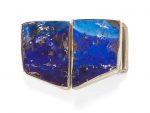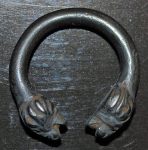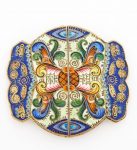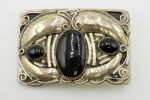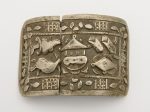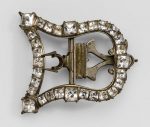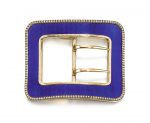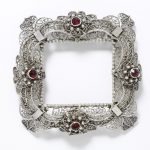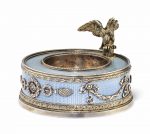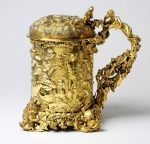Buckles were first introduced by the Romans in the 1st century. It was normally the Military and High Social Classes that used buckles in this era. They were regarded as symbols of Social Rank up until the 13th Century.
Belts were important features of early medieval dress. Not only did they serve the practical function of holding weapons and tools, but their fittings, which could vary in terms of material, decoration, and size, were also highly visible indicators of rank and status. Iron buckles, many imposing in size, were worn by both men and women. Their intricate decoration was achieved by squeezing narrow twisted strips of silver into patterns engraved on the surface of the prefabricated iron pieces. A complete belt would have consisted of a buckle, a counter plate that was placed opposite the buckle, and sometimes a rectangular plate placed in the middle of the belt at the back for decoration. Reference: The Metropolitan Museum
Many 13th Century buckles were used to fasten girdles or waist belts. The 14th Century also saw the emergence of shoe buckles. These may even have occurred during the 13th Century as well.
The Medieval times produced more decorative buckles, some being made of precious metals and adorned with paste stones. The use of precious stones was forbidden by Sumptuary Law. In Elizabethan times this law meant that no one of lesser class than Knights or Baron’s Sons were allowed to wear buckles or girdles.
Boulder Opal and Silver Belt Buckle Queensland, Australia An art jeweler’s piece, comprising two trapezoidal boulder opals, a “split” of one original specimen. Contour polished to reveal the surface colors of brilliant, electric blue, purple and turquoise. Both sections completely bezel-set and backed with silver, with belt hook closure. Length 2 3/4in
Sold for US$ 343 (£ 262) inc. premium at Bonhams in 2018
Roman silver buckle; flat penannular ring terminating in heads of lions; pin missing. 1st Century – 4th Century
Reference: © The Trustees of the British Museum
AN OTTOMAN GEM-SET SILVER-GILT BELT BUCKLE TURKEY, SECOND HALF 17TH CENTURY Composed of three parts, with domed central boss, each element set with rubies and other gems in floral and foliate motifs 8 ¾in. (22.4cm.) long
Sold for GBP 16,250 at Christies in 2018
Russian Silver-Gilt and Cloisonné Enamel Belt Buckle Mark of Feodor Rückert, Moscow, 1908-1917 Scallop shaped, the central panel enameled with varicolored and shaded enamel floral scrolls on a pale green ground, marked on reverse. Height 2 3/8 inches (6 cm), width 2 1/2 inches (6.4 cm).
In good condition; minor chip to green enamel on one side; light surface wear to silver.
Sold for $3,437 (includes buyer’s premium) at Doyle New York in 2017
Heavy Sterling Silver & Black Onyx Belt Buckle. Measures – 3″ long x 2 1/8″ wide. Weight – 97.5 grams.
Sold for $100 at Antiques & Art International in 2018
Silver Shoe Buckle late 600’s. Made in Northern France Culture: Frankish
Reference: The Metropolitan Museum of ArtIn Georgian times the Shoe Buckle was extremely popular. These were often made in silver and decorated with paste stones.
Nurses Buckles are also an extremely collectible item. If you are very lucky you may still find some with a black belt attached. The black belt was given when a nurse passed her SRN but only a Ward Sister was allowed to wear a Silver Buckle. Art Nouveau or Victorian Silver Nurses Buckles are very popular.
Other types of buckles to collect include Cowboy Buckles and Military Buckles.
Silver buckle for puttees for women with bound feet Made Qing Dynasty This silver buckle was designed to be attached to leggings (oufu; xiku) and worn by women with bound-feet shoes in China. Together with other accessories this buckle helps to illustrate the Chinese practice of foot binding which lasted for a thousand years in China. Whilst the practice appears to have been born partly of a male fantasy that eroticised women with tiny feet and has been linked to female oppression, new sets of meaning associate bound feet with motherhood and celebration of women’s rituals and artistic practice at home.
Reference: Museum of Applied Art and Sciences
Buckle about 1750–80
Knee buckle? Square-cut paste set in silver. Steel tongue with heart and scrolled decoration.
Reference: Museum of Fine Arts Boston
A Fabergé jewelled silver-gilt and enamel belt buckle, workmaster Michael Perchin, St Petersburg, 1899-1903 of rounded rectangular form, enamelled in translucent blue over moiré engine-turning within seed pearl and bead-and-spindle borders, struck with workmaster’s initials and Fabergé in Cyrillic, 88 standard width 7.1cm, 2 3/4 in.
Sold for 5,000 GBP at Sothebys in 2018
Hat buckle Place of origin: Schwäbisch Gmünd (made) Date: 1800-1870 (made) Square silver filigree frame of a buckle, set with four red pastes in filigree rosettes, linked by curls of filigree ribbon. Fittings missing.
Men’s hats in south Germany traditionally had a wide brim and high crown. The owner added a broad ribbon round the base of the crown to decorate it, fastened at the side with a silver filigree buckle, like this one. It would originally have had an iron bar in the centre, with a prong to fasten it. Glass pastes imitating precious stones (in this case garnets) are typical of jewellery from the south German region.
Reference: © Victoria and Albert Museum
